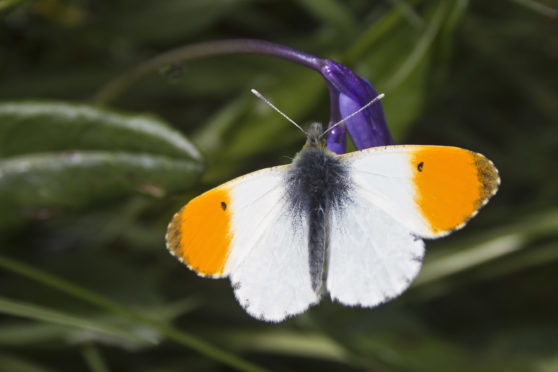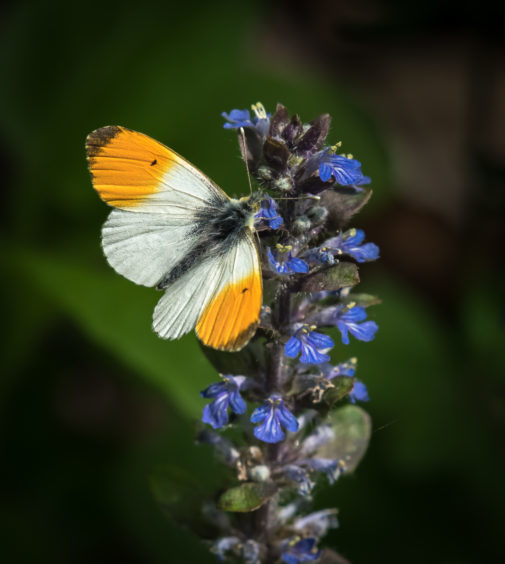Cast upon the air like a fluttering piece of orange and white confetti, the little butterfly danced and birled above the grass and wildflowers of this Fife cliff top.
It was an orange-tip butterfly – the first one I had seen this year – so I followed its progress like a man possessed in the hope of capturing a photograph. But each time it seemed about to alight on the ground, a new zest of life filled its wings, and up on its way the butterfly went once more.
Orange-tips have been described as ‘feel good’ butterflies, and no wonder, because they have a brightness and freshness about them that mirrors a crisp freshly ironed table cloth. It is the brightness of the orange combined with that dazzling whiteness; a happy and reinvigorating contrast. The French call the orange-tip ‘aurora’, representing the glowing sun at daybreak.
Here, it was also once known as the ‘lady of the woods’, but that is a rather inappropriate name, as it is more a butterfly of grasslands and hedgerows, where it can seek out its favoured plants to lay eggs on such as cuckooflower and garlic mustard.
This small stretch of cliff top between Earlsferry and Shell Bay is a wonderful place for wildflowers and on my most recent visit several varieties were coming into bloom, including hazy rose-pink cushions of thrift, along with meadow saxifrage, dandelions and red dead-nettle.
Thrift, or sea-pink, is one of our classic coastal flowers, and when examined up close, the petals reveal an intricate array of little pinkish frills. The narrow leaves are undistinguished and tight, probably so as to help conserve water in this place of persistent salt-laden winds and well-drained soils.
As we neared Shell Bay, a commotion out at sea caught my eye. It was a group of drake eiders –about 15 birds – and the water in among them heaved and boiled as if they were at the centre of a mini-tempest. But the sea all around was calm and benign. How strange.
I brought the ducks into focus with my binoculars and realised that in the middle of this maelstrom was a lone female eider; a little brown head surrounded by the black and white drakes. The water was bubbling from the rapid paddling of the drakes webbed-feet as they swirled around her excitedly looking for an opportunity to mate. One couldn’t help but feel sorry for her; the testosterone fuelled drakes seemed so consumed in their fervour that there was every chance she could end up getting hurt.
As we turned back towards Earlsferry, a brown hare erupted from beneath our feet and bounded up a grassy slope with astonishing acceleration. The sheer speed and wariness of this hare reminded me of the words of Thomas Pennant, the 18th century naturalist, who wrote that the hare’s ‘preserving passion was fear, making it perpetually attentive to every alarm’. So true, for our hares are like coiled springs, always on the lookout for danger.
Info
Orange-tip butterflies are on the wing during May and June. Only the males have orange wing tips. They have spread their range in Scotland in recent times and are more frequent than they used to be.











